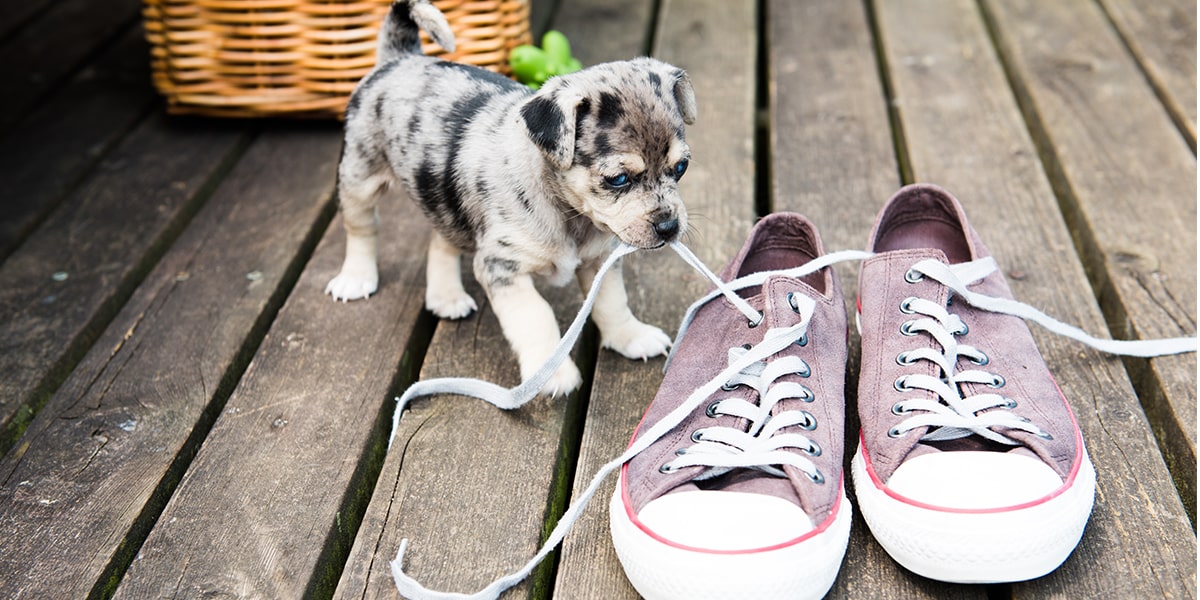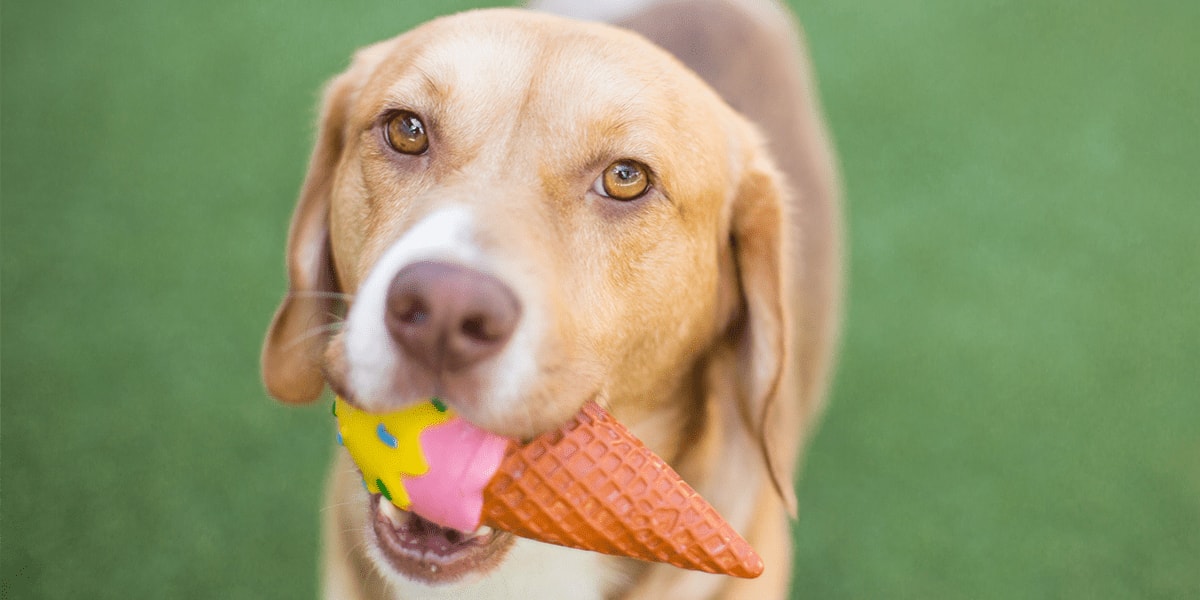How to train my dog not to chew things
Training your dog or puppy not to chew things that could be dangerous or that you don’t want them to ruin doesn’t have to be a tricky task. There are simple ways you can train them to chew the right things.
Puppies and many adult dogs love to chew anything they can get their paws on, which is fine when it’s their toys but not so great when they chew their owner’s belongings or swallow something dangerous! Our vets have put together their tips to help train your puppy or dog to chew their toys rather than your shoes or furniture.
Why do dogs chew?
Chewing is a natural part of being a dog. Puppies will often chew as part of their development and most dogs will like to chew throughout their lives.
It’s important to first understand why dogs chew. It’s a myth that dogs chew to annoy you or out of spite. This isn’t the case – dogs just need to chew something and might not have enough options to do it safely and appropriately.
Speak to your vet about possible reasons as they will be able to recommend appropriate action to take if your dog is chewing excessively. If you can understand the reasons behind why your dog is chewing, addressing these will help with the problem. For example, if your dog chews due to separation anxiety, working on that anxiety with an accredited behaviourist as well as following the tips below will really help your dog. If it’s due to boredom, extra walks and playtime can be really valuable. If it’s a medical issue, your vet can help you treat the cause.
Some reasons dogs chew include:
- Teething. Young puppies will chew a lot when they are teething, just like human babies do, to help ease their sore gums. Puppies learn really quickly so when they’re still young is the easiest time to teach them to chew pet-safe toys and not your furniture or shoes.
- Boredom. If your dog is bored or they don’t get enough exercise and playtime, they are more likely to chew things they shouldn’t.
- Missing nutrients. Some dogs will chew if they are eating an unbalanced diet to try and get some of the vitamins or minerals they are missing! Always make sure they are given a complete commercial dog food.
- Attention. This is a learned one. When your dog chews something they shouldn’t, you’ll react and they might see being chased around the room as a fun game. It may be their way of getting your attention if they want to play or spend time with you.
- Distress or frustration. Chewing can act as a “self-soothing” behaviour for dogs that are stressed. This could be down to separation anxiety, or anything else making them feel uncomfortable. We recommend you don’t regularly leave your dog for more than four hours (but some dogs might not be able to be left even that long before becoming worried).
- Medical. There may be a medical reason your dog is chewing, so it’s important to visit your vet to rule out medical conditions if your dog’s chewing habits change.
How can I stop my dog or puppy from chewing my things?

Remember that dogs do have a natural urge to chew. Chewing the right things can help keep a dog’s jaws strong, their brains active and their teeth clean. Luckily, it can be fairly straightforward to train them to chew the “right” things. There are several steps you can take to protect your possessions and furniture from curious mouths. These tips are best used from an early age, but adult dogs will be able to learn too – it might just take a bit more patience from you.
Redirection. If you catch your dog chewing something they shouldn’t, don’t punish them. Positive, reward-based training methods are far more effective than punishing your dog. This is because punishment can just make them scared of you and they will probably learn to hide their chewing by doing it when you are not there, rather than stopping. Instead, distract them with a safe dog toy they can chew and make sure to give them lots of praise when they start chewing on this.
Chews. Make sure your dog has access to plenty of chews. This can include treats and safe chew toys. Pay attention to which toys your dog prefers and make sure you rotate them regularly so they don’t get bored. We wouldn’t recommend giving them rawhide to chew as it can splinter and potentially hurt your dog.
Pet proofing. Make sure anything that may be harmful to your dog is put somewhere they can’t get to. It’s important to keep any poisons and hazards out of paw’s reach, especially if your dog likes to chew everything they can physically get to. If you need to go out and your dog has anxiety when left alone, it can be a good idea to confine them to one room or a large crate (as long as they are crate trained and happy in it) and give them plenty of safe activities to do while you’re gone. This way they can stay somewhere safe while you are out of the house. Crate confinement isn’t a long term solution so you’ll need to work on your dog’s separation anxiety.
Exercise. Make sure your dog gets plenty of exercise and playtime every single day as this can make them less likely to chew. There are lots of different types of exercise your puppy can do to keep them active. There are also exercises you can do with your dog to keep both of you fit and healthy.
If you are continuing to have problems with your dog chewing, you may want to seek the advice of an accredited behaviourist to help.
Which kind of chews and chew toys are best for dogs?

There are lots of chews and chew toys out there and it can be difficult to know what’s best for your dog. Our vets have put together their top tips on how to choose ones that are safe, fun and your dog will love!
Safe chew toys are:
- Designed for chewing. Most soft toys or tug of war ropes, tennis balls and Frisbees are only meant for supervised play and shouldn’t be given to your dog to chew on. They won’t last long under your dog’s jaws and more importantly they could be dangerous.
- Soft enough to indent with your fingernail. Anything harder than this can cause fractured teeth or bleeding gums, as it’s too hard for your dog to chew safely – especially if they are a strong chewer.
- Bigger than your dog’s throat. The whole toy shouldn’t be able to fit completely in your dog’s mouth. Many chew toys have different sizes for different sized dogs so make sure you get the right one. This is so they can’t accidentally swallow or choke on them.
- Safe if pieces are accidentally swallowed. Toys with long pieces of rope or lots of stuffing can cause gut blockages, which can be fatal.
Safe chew treats are:
- Soft enough to indent with your fingernail. Just like chew toys, if they are too hard they can damage teeth and gums.
- Safe for your dog. Bones aren’t a good chew treat, as they can break teeth, or splinter in the stomach and pierce the guts. Even if they don’t, they can cause constipation due to high levels of calcium, or even a gut blockage if large pieces are swallowed. Like bones, rawhides can also break into large pieces that can be swallowed and cause a blockage. They can also have dangerous bacteria or unsafe chemicals in them (particularly if imported), so we’d recommend steering clear. Make sure that you trust the source of the treats and that they don’t contain anything that’s dangerous for dogs.
- Only fed to them now and then. Depending on the treat, they can add a lot of extra calories. Remember to reduce the amount of food you give them that day a bit as well so they’re not getting extra calories.
- Ones your dog actually chews. If they chomp down on the treat without chewing much then they’re getting all of the calories and none of the benefits of chewing. If your dog has a tendency to just eat chew treats then toys might be a better option!

